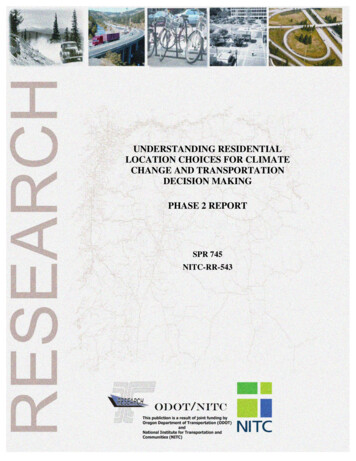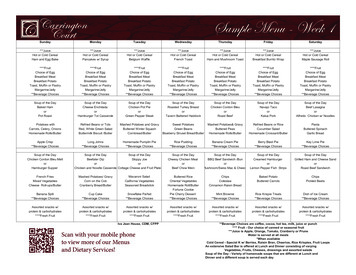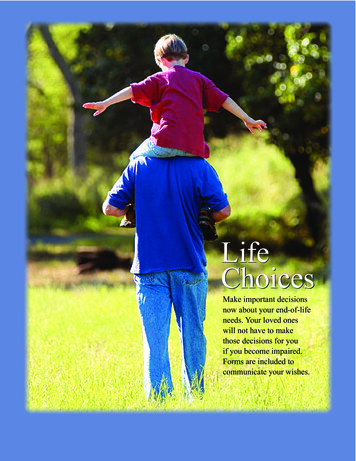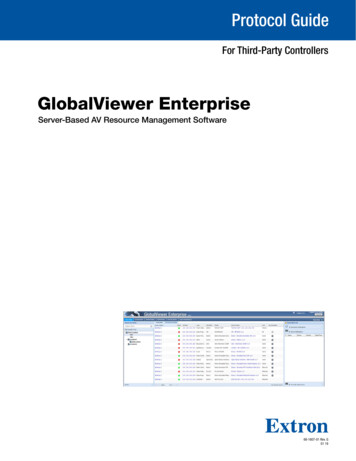
Transcription
CATIONCHOICESFORCLIMATELOCATION CHOICES FORCLIMATECHANGEANDTRANSPORTATIONCHANGE AND TRANSPORTATIONDECISIONMAKINGDECISIONMAKINGPHASE2 REPORTPHASE2 REPORTSPR 745SPR 745NITC-RR-543NITC-RR-543
UNDERSTANDING RESIDENTIAL LOCATIONCHOICES FOR CLIMATE CHANGE ANDTRANSPORTATION DECISION MAKINGPhase 2 ReportSPR 745NITC-RR-543byKelly J. Clifton, PhD; Steven R. Gehrke; Kristina M. CurransDepartment of Civil & Environmental EngineeringP.O. Box 751Portland State UniversityPortland, OR 97207forOregon Department of TransportationResearch Section555 13th Street NE, Suite 1Salem OR 97301andFederal Highway Administration400 Seventh Street, SWWashington, DC 20590-0003February 2015
Technical Report Documentation Page2. Government Accession No.1. Report No.:OR-RD-15-114. Title and SubtitleUNDERSTANDING RESIDENTIAL LOCATION CHOICESFOR CLIMATE CHANGE AND TRANSPORTATIONDECISION MAKING7. Author(s):Kelly J. Clifton, PhD; Steven R. Gehrke; Kristina M. Currans9. Performing Organization Name and AddressOregon Department of TransportationResearch Section555 13th Street NE, Suite 1Salem, OR 9730112. Sponsoring Agency Name and AddressOregon Dept. of TransportationResearch SectionandFederal Highway Admin.555 13th Street NE, Suite 1400 Seventh Street, SWSalem, OR 97301Washington, DC 20590-00033. Recipient’s Catalog No.5. Report DateFebruary 20156. Performing OrganizationCode8. Performing OrganizationReport No. SPR 74510. Work Unit No. (TRAIS)11. Contract or Grant No.13. Type of Report and PeriodCovered: SPR 745 Phase 2NITC-RR-54314. Sponsoring Agency Code15. Supplementary Notes16. Abstract: This research builds on the related Phase 1 project. In this second phase, we continue tostudy neighborhood and housing preferences that shape the residential location decision process. Anonline experimental survey tool is developed to investigate lifestyle preferences and tradeoffs thathouseholds make in their location decisions. This computer-aided experimental survey draws uponstated preference methods to engage participants in questions about residential location andtransportation options. The survey infrastructure was extensively piloted (6-10% response rate). The10-minute survey can be deployed for future investigations. This infrastructure is a contribution forthe integration of visualized neighborhood typologies, or concepts, which were objectively definedusing data from 25 of the most populous metropolitan regions from around the United States. Theconstruct of neighborhoods is based upon national data to account for potential options not currentlyavailable in Oregon. These visualizations help ground the survey respondents in the same reality andwere carefully crafted to convey various attributes of the built and transportation environment. Theinitial analysis of the preference data collected in this survey (N 1,035) indicates that thepreferences for neighborhood, housing, and transportation characteristics have a greater influence onthe preferred neighborhood concept than the more typically used socio-economic characteristics(income, household size, age). Another interesting preliminary finding is that 27% of respondentswould prefer to live in a more urban neighborhood than they currently reside. These “urban seeking”respondents had no particular demographic trend, providing little evidence that specificsocioeconomic markets had specific preferences for the built environment.17. Key Words: Residential choice, neighborhood18. Distribution Statementchoice, stated preference, experimental survey, survey Copies available from NTIS, and online atinfrastructure, national neighborhood conceptshttp://www.oregon.gov/ODOT/TD/TP RES/19. Security Classification (of21. No. of Pages 22. Price20. Security Classification (ofthis report)this page)140UnclassifiedUnclassifiedTechnical Report Form DOT F 1700.7 (8-72)Reproduction of completed page authorizediPrinted on recycled paper
ii
SI* (MODERN METRIC) CONVERSION FACTORSAPPROXIMATE CONVERSIONS TO SI UNITSSymbolWhen YouKnowMultiplyByTo FindAPPROXIMATE CONVERSIONS FROM SI UNITSSymbolSymbolWhen 3050.9141.61AREAin2square inches645.2ft2yd2acsquare feetsquare yardsacres0.0930.8360.405mi2square uaredmeters squaredmeters km2km2millimeterssquaredmeters squaredmeters litersmeters cubedmeters cubedSymbol(FCelsius C32)/1.8*SI is the symbol for the International System of lesinftydmi0.0016square inchesin210.7641.1962.47square feetsquare yardsacresft2yd2ac0.386square milesmi2VOLUME0.034fluid ounces0.264gallons35.315 cubic feet1.308cubic 02TEMPERATURE (exact)FahrenheitTo FindLENGTHVOLUMEfl oz fluid ubic feet0.028meters cubedm33ydcubic yards0.765meters cubedm3NOTE: Volumes greater than 1000 L shall be shown in short tons (2000T0.907megagramsMglb) FMultiplyByfl ozgalft3yd3ouncespoundsozlbshort tons (2000 lb)TTEMPERATURE (exact) CCelsius1.8C 32Fahrenheit F
iv
ACKNOWLEDGEMENTSThe authors would like to acknowledge our technical advisory committee for their commentsand feedback throughout the process of both stages of this project. Funding from the OregonDepartment of Transportation and the National Institute for Transportation and Communitieswas also provided for the Phase II of this study.DISCLAIMERThis document is disseminated under the sponsorship of the Oregon Department ofTransportation and the United States Department of Transportation in the interest of informationexchange. The State of Oregon and the United States Government assume no liability of itscontents or use thereof.The contents of this report reflect the view of the authors who are solely responsible for the factsand accuracy of the material presented. The contents do not necessarily reflect the official viewsof the Oregon Department of Transportation or the United States Department of Transportation.The State of Oregon and the United States Government do not endorse products ofmanufacturers. Trademarks or manufacturers’ names appear herein only because they areconsidered essential to the object of this document.This report does not constitute a standard, specification, or regulation.v
vi
EXECUTIVE SUMMARYThis report describes the design, development, administration, and empirical application of anexperimental survey infrastructure built to associate a household’s residential location choice andtheir housing, neighborhood, and transportation preferences. The primary goal of the phase of theproject described in this report is to develop an online experimental survey tool to investigatelifestyle preferences and tradeoffs that households make in their location decisions. Thiscomputer-aided experimental survey draws upon stated preference methods and integratesvisualized neighborhood concepts to engage survey participants in the questions about residentiallocation and transportation options. The infrastructure can be used to collect informationregarding residential neighborhood, housing, and transportation choices and preferences, whichmay include targeting to specific market segments, examining current or changing preferences,emphasizing policy directives or needs, and aiding in the supplementation of existingtransportation-land use models and tools.The infrastructure developed also includes the definition and visualization of a universal set ofneighborhood types. The development and testing of the six, nationally defined, neighborhoodconcepts can be found within Section 3.1 (satisfying Task #4 and #5). The testing of ourvisualized neighborhood concepts included a pilot survey administered online, and recruitedthrough US Postal Service postcards. This survey allowed the research team to (a) pilot the maincomponents of the survey instrument, (b) test the response rate from a survey administered froma single postcard, and (c) validate the visualized survey respondents, testing the ability forrespondents to “get on the same page” when viewing our neighborhood concept image sets.To test the online infrastructure developed by the research team (Tasks #7 and #8), neighborhoodchoice and commute (mode and travel time) tradeoffs were investigated within a full-factorialchoice-based conjoint experiment. With three neighborhood levels (Central District, UrbanDistrict Neighborhood, and Urban Neighborhood), three commute mode levels (car, publictransit, and bike/walk), and three levels of travel times (15, 30, and 60). Each experimentalsurvey respondent completed the five choice scenarios required to conduct experimentalanalysis—choosing between two “cards”—and then they were given the option to complete fiveadditional choice scenarios. The 10-12 minutes survey was administered via Qualtrics online,and recruited from two sample frames: (a) a random sample of Portland residents from theReferenceUSA database (N1 8,000; 6% response rate) and (b) all non-Portland 2009-2011Oregon Household Activity Survey respondents who agreed to be contacted again for a followup survey (N2 5,249; 10% response rate). Although the experimental survey had a low averageresponse rate (approximately 8%), 83% of respondents who completed the experimental portionof the survey choose to complete ten tasks, instead of the minimum requested five choicescenarios. This indicates that although the response rate is lower, respondents are more willing to“burden” themselves by completing additional hypothetical choice questions.The experimental analysis of the collected stated neighborhood preference survey (see Section3.3) indicates more influence of the preferences for a variety of neighborhood, housing, andtransportation characteristics, rather than the more typically used land use-transportationattributes: income, household size, and age. Ideas for future research or analysis of the collecteddata are included in this section.vii
The Phase II conclusions in Section 4.0 consist of a discussion of the lesson’s learned fromdevelopment and piloting of the survey infrastructure, a summary of the major findingssuggested from the experimental analysis of the piloted survey, and information about potentialfuture work related to the this project. This section concludes with a discussion of the ways inwhich this survey infrastructure might help to inform policy needs and directives, as well as howit might be applied to supplement and improve the representation of residential neighborhoodand transportation choices within existing models and tools in Oregon.viii
TABLE OF CONTENTS1.0INTRODUCTION. 12.0LITERATURE REVIEWS . 32.1LITERATURE REVIEW OF NEIGHBORHOOD CONCEPTS . 32.1.12.1.22.1.3Conceptualizing Neighborhood . 3Representing Neighborhood Concepts. 5Literature Review of Influential Residential Location Attributes . 62.1.3.12.1.3.22.1.3.33.0Housing Characteristics. 7Neighborhood Characteristics . 8Transportation Characteristics . 8METHODOLOGY . 113.1DEVELOPING NEIGHBORHOOD CONCEPTS . 123.1.1Defining Neighborhood Concepts. 133.1.1.13.1.1.23.1.2Visualizing Neighborhood Concepts. 183.1.2.13.1.2.23.1.3Housing Characteristics. 27Accessibility Characteristics . 27Transportation Characteristics . 28Summary and Discussion . 293.1.5.13.1.5.23.2Design of Validation Survey Instrument . 20Recruitment of Validation Survey Respondents. 23Analytical Approach to Validation . 24Results . 263.1.4.13.1.4.23.1.4.33.1.5Image Selection Process . 19Internal Trial and Image Set Completion . 20Validating Neighborhood Concepts . 203.1.3.13.1.3.23.1.3.33.1.4Study Area and Data Description . 13Direct Method Approach . 14Discussion . 29Future Work . 29RESIDENTIAL LOCATION PREFERENCES AND CHOICES. 303.2.1Experimental Survey Methodology . .3Design of Experimental Survey Instrument . 32Survey Component: Background Information. 32Survey Component II: Importance Rankings . 35Survey Component III: Choice-based Conjoint Experiment . 36Recruitment of Experimental survey Respondents . 37Summary Statistics of Experimental Survey Respondents . 38Summary . 41NEIGHBORHOOD PREFERENCE ANALYSIS . 413.3.1Analytical Approach . 423.3.1.13.3.1.23.3.2Neighborhood Preference Model Estimation Results . 493.3.2.13.3.2.23.3.2.33.3.2.43.3.3Data Description. 42Preference Model Specification and Estimation. 46Variables Most Associated with Neighborhood Preference . 49Summary of Model Performance . 51When do People Prefer Neighborhood C: Urban Residential Districts . 56When do People Prefer Neighborhood D: Urban Neighborhoods . 58Future Work: Methodology for Stated-Choice Experiment Analysis . 603.3.3.13.3.3.23.3.3.33.3.3.43.3.3.5Nested Logit Models and Trade-offs Between Neighborhood and Commute Mode . 63Formulating the Model . 64Maximizing the Likelihood and Calculating Probabilities . 65Systematic Components and Utilities . 66Interpreting NL Models . 67ix
3.3.3.63.3.3.73.3.3.83.3.3.94.04.14.25.0Evaluating Trade-offs in Neighborhood, Commute Mode and Travel Time . 68Controlling for Repeated Measures . 69Running specified Models on a Subset of Task-observations . 69Panel Mixed Logit (ML) Models . 70CONCLUSIONS . 73ASSESSMENT OF SURVEY INFRASTRUCTURE AND ADMINISTRATION . 73OPPORTUNITIES FOR IMPLEMENTATION AND FUTURE WORK . 75REFERENCES. 77LIST OF TABLESTable 3.1: Range of Built Environment Measure Values for Groups Defined by FNBCM . 15Table 3.2: Summary Statistics of the Neighborhood Concepts for Three Built Environment Measures at the CensusBlock Group Level for the 25 Most Populous US Metropolitan Regions . 17Table 3.3: Proportion of Survey Responses Evaluating Neighborhood Concept Pairings: “Indicate the neighborhoodthat you think is more likely to have.” . 25Table 3.4: Comparison of Objective versus Respondent Evaluation Outcomes: “Indicate the neighborhood that you(the respondent) think is more likely to have. . 26Table 3.5: Distribution of Sampled Oregon Residents by Neighborhood Concept and Work Status . 39Table 3.6: Distribution of Sampled Oregon Residents by Dwelling Type and Work Status . 40Table 3.7: Distributions of Sampled Oregon Residents by Common Travel Mode and Work Status . 41Table 3.8: Descriptive Statistics for Socioeconomic Characteristics for Preference Dataset . 43Table 3.9: Descriptive Statistics for Residential Location Characteristics for Preference Dataset . 44Table 3.10: Descriptive Statistics for Transportation Characteristics for Preference Dataset . 45Table 3.11: Importance Ranking of Residential Location Choice Items for Preference Dataset . 46Table 3.12: Neighborhood Concept Preference Model Estimation (Base Suburban Neighborhood/EF) . 47Table 3.13: Neighborhood Concept Preference Model Estimation (Base Suburban Neighborhood/EF) - Continued. 48Table 3.14: Comparison of Current and Stated Neighborhood Preference. 50Table 3.15: Neighborhood Preference Model Accuracy—Predicted versus Stated Preferences . 52LIST OF FIGURESFigure 3.1: Illustration of Aggregation Process used to define the Neighborhood Concepts . 16Figure 3.2: Spatial Distribution of Neighborhood Concepts in Portland, San Francisco, and Seattle . 18Figure 3.3: Example of Image Set Comparison found in Validation Survey Instrument .23Figure 3.4: Neighborhood Concepts in Experimental Survey . 34Figure 3-5 Illustration of a Potential Task in the Choice-based Conjoint Experiment Error! Bookmark not defined.Figure 3.6: Recruitment Postcard . 38Figure 3.7: Observed Distribution of Stated Neighborhood Preferences by Annual Household Income . 51Figure 3.8: Individual-Level Variables- Contribution to the Change in Probability of Neighborhood Preference, allother variables at their mean value. 54Figure 3.9: Importance Ranking Preferences - Variable Contribution to the Change in Probability of NeighborhoodPreference, all other variables at their mean value . 55x
Figure 3.10: Fitted Probabilities for Neighborhood Preference, All Other Variables at the Mean Values . Error!Bookmark not defined.Figure 3.11: Observed Distribution of Stated Neighborhood Preferences by Respondent Age . 59Figure 3.12: hree cards: each with one of the three alternatives for neighborhood, commute mode and commutetravel time . 61Figure 3.13: Joint multinomial logit structure. . 63Figure 3.14: Proposed nested logit structure. 64Figure 5-1 Neighborhood Concept Image Sets and Descriptions . 21xi
xii
1.0 INTRODUCTIONUnderstanding the changing preferences of differing market segments is key toward improvingthe representation of residential locations choices in integrated land use and travel demandmodels and more importantly fundamental to understanding the drivers for future housing, landuse and transportation policies. As communities struggle to address rising challenges in publicinfrastructure provision, climate change preparation, energy and natural resource consumption,and the creation of a sustainable future given present economic uncertainty, transportation andland use plans have become increasingly predicated on assumptions concerning the market forvarious types of dwelling units, residential environments, and travel modes. However, if plannerslack faith in the estimates of these travel demand models, the long range supply of housing,activity locations, and transportation facilities will be insufficient to meet future demands. Inresponse, an added importance has been placed on the development of innovative tool setscapable of providing a robust and flexible understanding of how differing assumptions contributeto a set of planning scenarios and impact future residential location decisions.This report describes the design, development, administration, and empirical application of anexperimental survey design targeted toward assessing the multitude of connections that areassociated with a household’s residential location choice and their preferences for varioushousing, neighborhood, and transportation characteristics. An improved identification andunderstanding of the factors that most influence this complex residential location decisionmaking process carries great potential for refining scenario planning exercises and providing amore policy-sensitive depiction of these influential factors in existing transportation analysistools. Specifically, the administration of the experimental survey design and insight provided bythe initial analysis of the data collected from results from its early implementation described inthis report has the ability to be integrated into a variety of modeling tools available tometropolitan regions and states, including the sophisticated land use, transportation, andgreenhouse gas models utilized in Oregon.The primary goal of the phase of the project described in this report is to develop an onlineexperimental survey tool to help understand the lifestyle preferences and key tradeoffs thathouseholds make in their location decisions. This computer-aided experimental survey will drawupon various stated preference methodologies and will integrate visualization of the physicalattributes of housing choices and neighborhood types to engage survey participants in thequestions about residential location and transportation options. The tool will be useful incollecting information to better understand future neighborhood, housing, and transportationpreferences of key market segments.This research is the second phase of a project examining the relationships between the residentiallocation decisions of Oregon residents and the transportation implications of the revealed andstated choices. In the first phase of this project, the research team used revealed preference datato identify a set of lifecycle stages and model the impact of their observed residential location1
decisions on travel outcomes such as miles traveled, trip frequency, and automobile ownership1.In this second phase, the research team complements this prior Portland-based work with thedesign of a data collection methodology to support a stated preference analysis that will allowbetter understand how current residential location and transportation choices of Oregon residentsrelate to their preferences for certain dwelling types and neighborhoods. The design andapplication of the stated preference survey techniques used in this second phase further providesthe infrastructure needed to enhance the ability of present policy tools to forecast the impact ofhypothetical residential conditions or unrealized lifestyles on future housing, neighborhood, andtransportation decisions.More specifically, the experimental survey described hereinafter introduces an innovative tool toexamine the important tradeoffs that household members make when choosing a neighborhood,dwelling type, and commute mode. In an attempt to better understand these complicatedtradeoffs and provide the survey infrastructure necessary to answer other advanced residentiallocation topics, the project includes the following innovations in this survey methodology andthe outcomes: The development of neighborhood concepts, or typologies, that are grounded in anobjective analysis of the physical attributes of neighborhoods. The use of a set of tested and validated imagery to convey these neighborhoodconcepts in the survey instrument. A survey instrument that integrates visual imagery and allows for onlineadministration. A tested stated-preference survey methodology that is guided by a goal of collectingdata to support discrete choice experiment analyses. An initial data set and analysis from the piloting of this methodology. A framework for analyzing these and future choice experiment data.The report is divided into four major sections, including this introduction. The following sectionincludes the literature review. The literature review has two parts. First, we discuss the conceptof neighborhood and how it is defined. Then, we delve into the area of literature that discussesthe influential locational a
choice-based conjoint experiment. With three neighborhood levels (Central District, Urban District Neighborhood, and Urban Neighborhood), three commute mode levels (car, public . The 10-12 minutes survey was administered via Qualtrics online, and recruited from two sample frames: (a) a random sample of Portland residents from the .











